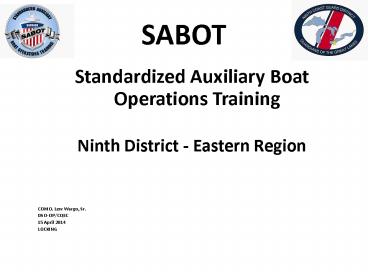SABOT - PowerPoint PPT Presentation
1 / 14
Title:
SABOT
Description:
Commercial tows 5. Commercial fishermen 6. Recreational craft LOCKING PROCEDURES 1. Before locking the coxswain shall brief the crew on the locking evolution. 2. – PowerPoint PPT presentation
Number of Views:112
Avg rating:3.0/5.0
Title: SABOT
1
SABOT
- Standardized Auxiliary Boat Operations Training
- Ninth District - Eastern Region
- COMO. Lew Wargo, Sr.
- DSO-OP/CQEC
- 15 April 2014
- LOCKING
2
SABOT
- LOCKING
3
REFERENCES
- Boat Crew Seamanship Manual,
- COMDTINST M16114.5(series)
- Chapter 14
- Auxiliary Boat Crew Qualification Guide,
- COMDTINST M16794.51 52(series)
- SABOT Job Aid (Section D)
4
LOCKING
- Locks are not located in all areas. They are used
for boats to transit between bodies of water
having different water levels. - Most locks operate using gravity for the water to
flow from a higher pool to a lower pool.
5
LOCKING
- Locks are under the control of a Lock-Master
- who controls the lock and the boating traffic
- using the lock.
6
LOCKS
- The priority for locking is
- 1. U.S. military craft
- 2. Vessels carrying U.S. mail
- 3. Commercial passenger vessels
- 4. Commercial tows
- 5. Commercial fishermen
- 6. Recreational craft
7
LOCKING PROCEDURES
- 1. Before locking the coxswain shall brief the
crew on the locking evolution. - 2. The coxswain shall assign jobs to the crew
including preparation for locking. - 3. Facility is properly fendered and boat hooks
are kept ready fore and aft.
8
LOCKING PROCEDURES
- 4. Lock is contacted on the proper radio
- channel and arrangements for locking are made or
follow visual signals. - 5. Lock gate is not approached closer than 400
feet until the lockmaster signals to enter. - 6. Allow traffic to exit the lock before
entering.
9
LOCKING PROCEDURES
- 7. Proper sound signals are used
- 8. Rules of the Road are observed.
- 9. Notify the controlling unit that you are
- entering the lock (Radio communications
- may be lost while in the lock chamber).
- 10. Enter at slow speed.
10
LOCKING PROCEDURES
- 11. Watch for debris floating in the area of
- the lock gate.
- 12. Follow the directions of the lockmaster. If
- no directions are given position yourself
- behind the boat ahead or as far into the
- lock chamber as possible to allow room
- for additional boats.
11
LOCKING PROCEDURES
- 14. Proper lines are used (or provided if lock
- does not provide). Should be at least 50
- long with at least a 12 eye spliced in one
- end.
- 15. No line is secured to the vessel. Held by
- hand.
- 16. Some locks have a lot of turbulence in
- the area that water flows into the
- chamber.
12
LOCKING PROCEDURES
- 17. Do not exit the lock until signaled by the
- lockmaster (air horn).
- 18. Exit the lock in the same order as you
- entered.
- 19. Exit the lock at slow speed.
- 20. Watch for debris floating in the area of
- the lock gate.
13
LOCKING PROCEDURES
- 21. Debrief crew on the locking procedure
- a. Crew communicated effectively
- b. Crew was aware of each others
- position
- c. Coxswain provided appropriate
- guidance
14
LOCKING PROCEDURES
- d. No one jeopardized the crew safety
- e. Kept the controlling unit informed.































